VIMAR 02910 Timer-Thermostat
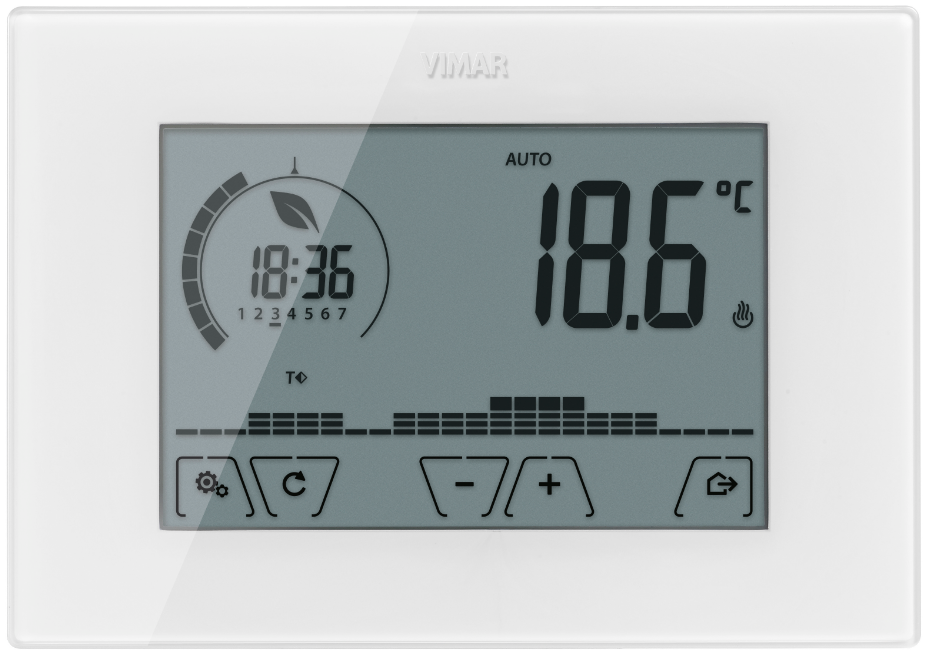
Timer-Thermostat 02910
The timer-thermostat 02910 ensures ideal temperature conditions for every hour of the day by acting on the control circuit of the burner or circulation pump (heating) or on the control circuit of the air conditioner (air conditioning). Thanks to a touchscreen display with an extremely user-friendly graphical interface, the user can manage the system easily and comprehensively while keeping the device in a state of energy saving. Consulting the consumption (or production) of energy (if configured) lets you monitor up to 3 different phases; the timer-thermostat does not activate/deactivate loads according to the power reading but performs monitoring with an audible alarm when needed.
Inserting new / replacement batteries
When replacing batteries, remove the front panel by raising it with a screwdriver. Replace the batteries with Alkaline 1.5V “AA” batteries.
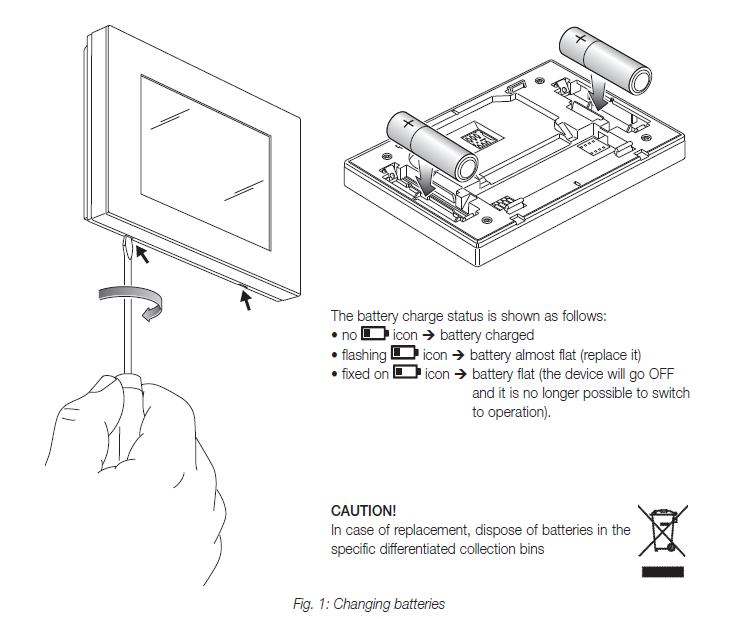
Display
The touchscreen display allows you to control the system using the following buttons and icons:
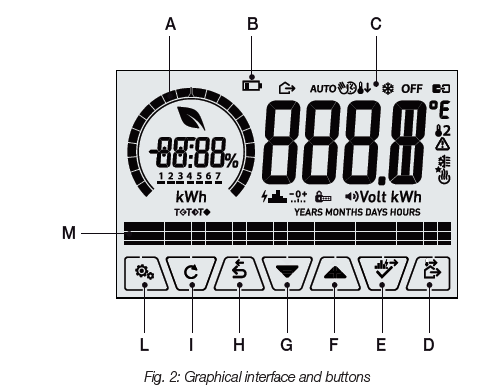
- Ring indicating consumption level and energy savings indicator B: Battery charge status
- Operating mode
- Away
- Confirm or energy log navigation
- Menu navigation and setting parameters
- Back
- Alternative viewing
- Settings menu
- AUTO program temperature trends and consumption log
![]() increase the numerical values. When it “disappears” from the display it means that the value cannot be increased anymore.
increase the numerical values. When it “disappears” from the display it means that the value cannot be increased anymore.
decreases the numerical values. When it “disappears” from the display it means that the value cannot be decreased anymore.
during navigation, it scrolls the next item through the available menus. If it “disappears” then you have arrived at the last of the items that can be scrolled.
during navigation, it scrolls the previous item through the available menus. If it “disappears” then you have arrived at the last of the elements that can be scrolled.
confirms the selected option (activates the submenu if there is one or displays the next parameter/digit).
After each confirmation, the display shows the icon for approximately 1 s. In addition, if the timer-thermostat is connected to probe 02960 via the circuit board 02915, it will also be possible to enable its acoustic signal.
back (or cancel) exits the current screen/menu and returns to the previous one without saving any changes. In menus with changes to multiple digits, it lets you go back to change the previous digit.
N.B. The field/value being edited is highlighted by the field/value itself flashing.
IMPORTANT: In order to avoid any accidental modifications, first press and hold down the required icon displayed to enable the function.
Symbols
Depending on the different operating modes, the display shows the following icons:
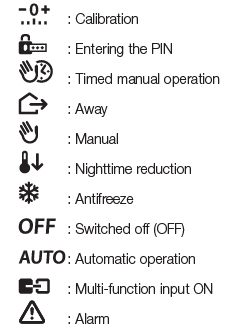

Locking the interface via PIN
The timer-thermostat lets you set a password which inhibits any change to the operating mode (eg switching from Manual to OFF), limits setting the temperature values, and, more generally, blocks access
to the configuration menu. This feature is useful to prevent the thermostat from being used by unauthorized persons: the device prompts you to enter the PIN, indicating a shutdown with the![]() icon
icon
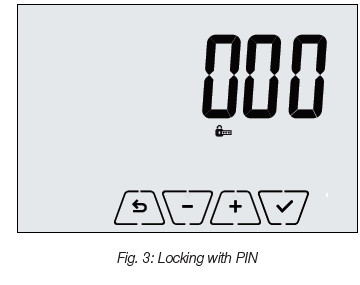
Alternative views
During normal operation, i.e. when you are not navigating the menus, you can select the information to display on the left-hand side of the display. If the right side always displays the measured temperature together with other data (which will be explained below), tapping in succession the![]() button on the left-hand side and in the program area will display the two following options:
button on the left-hand side and in the program area will display the two following options:
Clock, daily program and Ecometer

This view is the default and gives an indication of the daily temperature control program along with the data on the current moment. The program area, represented by histograms, is divided into 24 sectors each of which represents the corresponding hour of the 24 hours in a day. Each sector can be composed of 1, 2 or 3 dashes:
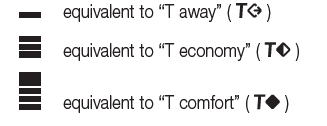
The clock shows the current time. The indicator of the day of the week highlights the current day with a dash under the number associated with it (eg, 4 = Thursday). The set temperature indicator highlights the current temperature being regulated thus replicating the information represented by the “dashes”:

The energy saving indicator indicates whether, compared to a conventional average consumption, the set temperature setpoint enables you to achieve “savings” in consumption. If the operating mode is not set on AUTO, the program area will not be active.

The set of icons called “ECOMETER” provides a general indication of the expected consumption facilitating energy saving. The consumption forecast is given by a comparison between the currently set temperature value and a conventional average consumption defined in the device.
- The ring of the level of consumption indicates the level of expected consumption; if the level is less than half the savings are expected with respect to the conventional average consumption, whereas if the level exceeds half then the expected consumption will be greater than average.
- The energy saving indicator indicates whether compared to the conventional average consumption, the set temperature setpoint enables you to achieve “savings” in consumption.
Consulting the energy probe (if enabled)
This mode appears only if there is an energy probe that has been suitably configured by your installer
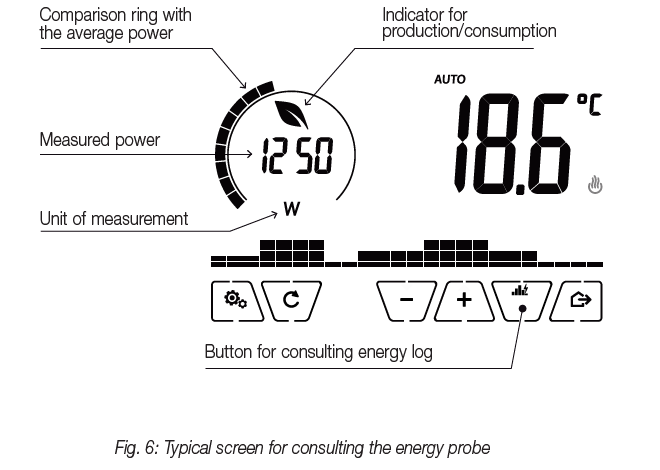
This option is used to consult data on the instantaneous power and energy consumed/generated by the system and measured instantly by the energy probe.
CAUTION: Proper operation and proper consultation require:
- The energy probe 02960 to be powered and functioning
- The energy probe 02960 is properly interconnected with the circuit board 02915
- The clock of the timer-thermostat to be set correctly
If these conditions are met, the indicator LED of the energy probe 02960 will flash “slowly” (1 flash every 2 seconds approximately). The measured power is the value measured by the energy probe 02960; the value shown is the sum of the (active) powers of all the active channels of the probe (eg, all 3 channels could be active, or only channel 1 or channels 1 and 3, etc.). The unit of measurement (W or kW) is displayed under the measured value.
- If the sum of the powers turns out to be consumed (i.e. absorbed by the energy supplier), the value is positive and the generation/consumption indicator is off.
- If the sum of the powers turns out to be generated (for example, the photovoltaic system is supplying power to the electricity grid), the value is negative, and the generation/consumption the indicator is on.
When consulting the power/energy data, the “consumption log” view provides a rough estimate of the consumption recorded in the last period. In particular, each horizontal group of dashes represents the year/month/day/hour depending on whether the word displayed is YEARS/MONTHS/ DAYS/HOURS respectively. The current year/month/day/hour is highlighted by the group of flashing dashes while the
previous and the next are represented by groups of dashes shown respectively to the left and right of the flashing group. The information provided is represented as follows:
- The circular ring (only when consulting the instantaneous power) represents the current level of consumption compared to the maximum level recorded in the last 24 h (ring complete with all the dashes = maximum consumption); the number of dashes can therefore vary even if the power is the same since what is displayed depends on the consumption log. Pressing and holding the central area (see fig.7), instead of the instantaneous power, displays the energy consumed (or generated) during the current day; in this case, the circular ring represents the level of consumption of the current day compared to the last 30 days. If the dashes reach halfway around the ring it means that the consumption in the last 24 hours is in line with that of the last 30 days; vice versa, if the dashes exceed or are less than half of the ring it means that the current consumption is respectively higher or lower than the average of the last 30 days.
Consulting the energy log
Touching![]() displays the historical data on energy consumption measured and saved by the energy probe 02960.
displays the historical data on energy consumption measured and saved by the energy probe 02960.
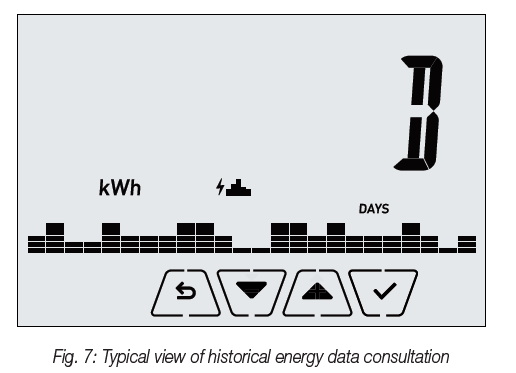
Via![]() and
and ![]() confirming with
confirming with![]() you set the range of historical consumption that you want to see:
you set the range of historical consumption that you want to see:
 historical data reset): this option lets you delete ALL the historical data saved by the energy probe; since this operation cannot be undone, an additional confirmation screen is displayed (YES to delete and NO not to delete).
historical data reset): this option lets you delete ALL the historical data saved by the energy probe; since this operation cannot be undone, an additional confirmation screen is displayed (YES to delete and NO not to delete). (hourly consumption): enables you to scroll one by one through the hours prior to the current one; the indices range from “0h” (current hourly consumption) to “-23h” (hourly consumption of 23 hours ago).
(hourly consumption): enables you to scroll one by one through the hours prior to the current one; the indices range from “0h” (current hourly consumption) to “-23h” (hourly consumption of 23 hours ago). (daily consumption): enables you to scroll one by one through the days prior to the current one; the indices range from “-0D” (current daily consumption) to “-30D” (daily consumption of 30 days ago).
(daily consumption): enables you to scroll one by one through the days prior to the current one; the indices range from “-0D” (current daily consumption) to “-30D” (daily consumption of 30 days ago).- (monthly consumption): enables you to scroll one by one through the months prior to the current one; the indices range from “-1M” (monthly consumption of the last month) to “-11M” (monthly consumption of 11 months ago).
N.B.: Monthly consumption (or generation) is considered to be the consumption (or generation) recorded in a fixed period of 30 days. The month “-1M” therefore represents the consumption recorded in the period from 30 days ago until yesterday. The month “-2M” represents the consumption recorded in the period from 60 days ago until 31 days ago, etc. - yearly consumption): enables you to scroll one by one through the years prior to the current one; the indices range from “-1Y” (yearly consumption of the last year) to “-3Y” (yearly consumption of 3 years ago).
N.B.: Yearly consumption (or generation) is considered to be the consumption (or generation) recorded in a fixed period of 365 days. The year “-1Y” therefore represents the consumption recorded in the period from 365 days ago until yesterday. The year “-2Y” represents the consumption recorded in the period from 730 days ago until 366 days ago, etc. - Confirming the selection will then display the energy consumed or generated in Wh or kWh. Obviously, if the energy probe was installed at a time when there were not yet any data for the period of consultation, the historical energy data will be 0. For example, if the probe was installed 20 days ago and we are consulting the term “-3 months” then the consumption is obviously 0 Wh.
Operating mode
The timer-thermostat 02910 is able to regulate the temperature according to the following operating modes:
- Switched off (OFF): switches the system off
- Manual (ON): lets you set the environment temperature set-point manually
- AUTO: lets you set a control program that compares the room temperature with the value set for each quarter of an hour of the current day; the user defines three levels of temperature distributed over 24 hours which can then be varied for each day of the week.
- Timed manual: starting from AUTO mode, this lets you activate MANUAL operation of the timer-thermostat for any period of time at the end of which the device will return to AUTO mode.
- Away: lets you set the set-point in order to achieve significant energy savings during periods when the user is away
- Antifreeze: used to set a minimum temperature level to avoid damage to pipework or prevent the temperature from falling below a safety level. In addition, if the multi-function input of the timer-thermostat has been suitably configured (your installer will give you the relevant information), you can remotely activate the following modes:
- Remote reduction: lets you vary the set points of MANUAL adjustment to obtain energy savings.
- Remote activation: lets you activate the system remotely, setting AUTO operation.
- Summer/Winter switching: the multi-function input automatically switches the timer-thermostat onto air-conditioning mode (when on) or heating mode (when off).
- The operating mode is selected via the SETTINGS menu or with the shortcut keys.
Switched off (OFF)
With this mode on, the timer-thermostat is turned off and you cannot make any adjustments; in this case, the icon is displayed above the temperature indicator. In this mode, you cannot perform any operations other than activating the menus or changing the view mode.
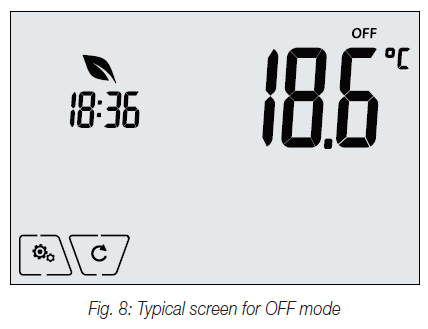
For heating-only systems, this mode is typically used in the summer.
Manual
In this mode the device operates as a simple thermostat and regulates the ambient temperature, taking it to the value set by the user. When MANUAL mode is active, the icon ![]() is displayed above the temperature indicator.
is displayed above the temperature indicator.
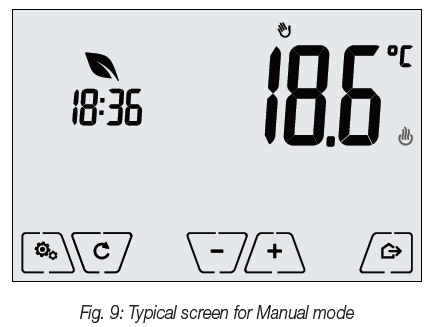
The set point can always be changed via ![]() or
or ![]() .
.
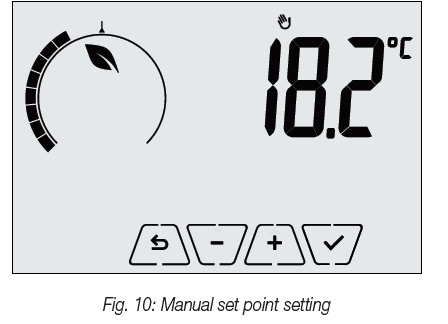
The selection is confirmed by touching![]() .
.
The![]() icons
icons![]() in the lower right corner indicate whether the system is operating in heating or air-conditioning mode respectively (icon illuminated = system on).
in the lower right corner indicate whether the system is operating in heating or air-conditioning mode respectively (icon illuminated = system on).
Auto
This is the typical mode of operation of the timer-thermostat. The device automatically changes the ambient temperature according to the time of day and the day of the week, it minimizes user intervention thereby optimizing comfort and energy savings; three different temperatures can be set to cover the needs of normal use, user away, or nighttime reduction in the environment. For setting the automatic program, see par. 8.5. When AUTO mode is active, the icon is displayed above the temperature indicator.
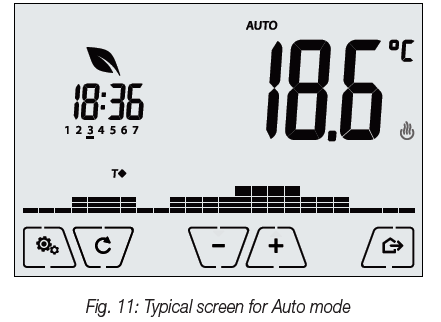
By touching  and
and  you can temporarily change the ambient temperature, setting it to a different value than the one associated with the current time slot. Confirming
you can temporarily change the ambient temperature, setting it to a different value than the one associated with the current time slot. Confirming ![]() with it then goes into TIMED MANUAL mode. The
with it then goes into TIMED MANUAL mode. The  icons
icons in the lower right corner indicate whether the system is operating in heating or air-conditioning mode respectively (icon illuminated = system on).
in the lower right corner indicate whether the system is operating in heating or air-conditioning mode respectively (icon illuminated = system on).
Timed manual
This mode allows you to exit the AUTO program (you enter MANUAL mode) for a certain time after which the timer-thermostat will return to AUTO mode. For example: take the ambient temperature to 25°C for 2 hours and then resume the Auto program. Activation is carried out starting from AUTO mode and is recognizable by the icon![]() displayed above the temperature indicator.
displayed above the temperature indicator.
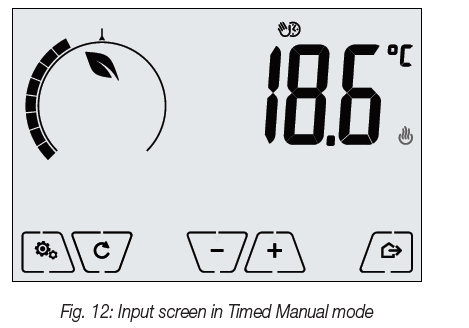
Using  you
you set the temperature and confirm with
set the temperature and confirm with .
.
The next screen, again using  and
and , lets you set the time for which the temperature you have just set is maintained.
, lets you set the time for which the temperature you have just set is maintained.
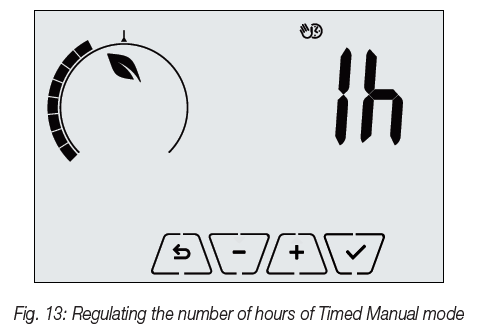
Finally, confirm with .
.
At the end of the set time, the timer-thermostat goes back into AUTO mode, and the icon switches off and reappears.
switches off and reappears.
Away
This mode is useful to achieve energy savings quickly and effectively whenever the user leaves the regulated room. In “Away” mode the system makes the adjustment according to the “away temperature” setpoint.
The Away mode can only be activated by touching![]() . The display will show the “away temperature” setpoint for approximately 2 seconds:
. The display will show the “away temperature” setpoint for approximately 2 seconds:

Mode activation is identified by the icon![]() :
:
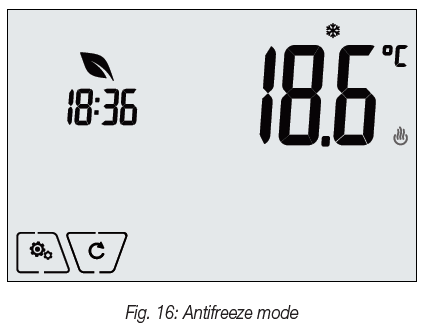
To exit and return to the initial mode touch the  button again:
button again:
Antifreeze
This mode, which can only be activated when the system is operating in heating mode, lets you set a minimum temperature value ( setpoint) to avoid damage to the pipework or to keep it from falling below
a certain safety level when you are away from long periods in the winter. The “antifreeze” mode is activated directly from the Settings menu. Once activated, antifreeze mode is identified by the icon![]() above the temperature indicator.
above the temperature indicator.

Remote reduction
Remote reduction is a useful way to “centralize” energy saving if there are multiple 02910 thermostats in different rooms of the same house.
Example: Before going to bed, using a simple switch, all the thermostats in the house are set onto “reduction” at the same time.
This mode comes into operation when the multi-function input is activated only if this has been suitably configured; the multifunction input is activated solely when the timer-thermostat, before the activation is in Manual mode (otherwise the multi-function input is ignored). In “Remote reduction” mode, the device regulates the temperature to a value equal to Tcomfort -; in this condition, the display and the relevant buttons must not be used (this is because the device is controlled by a remote). On disabling the multifunction input, the timer-thermostat returns to the previously set mode allowing the user to use all the device’s functions. The “Remote reduction” mode is identified by the![]() icons
icons ![]() located simultaneously above the temperature indicator.
located simultaneously above the temperature indicator.
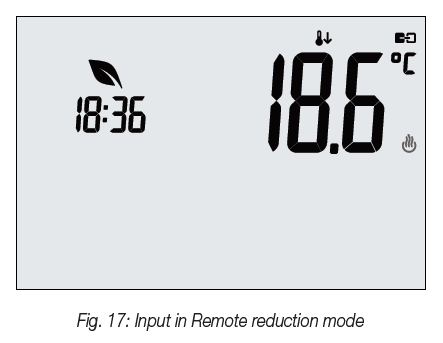
Remote auto
This mode is typically used in applications where you want to remotely enable or disable the temperature control of a room and limit the functions that can be performed by the user. This mode comes into operation when the multi-function input is activated (see par. 4.2) only if it has been suitably configured. In “Remote auto” mode, the timer-thermostat is activated in AUTO mode. In this condition, the display and the relevant buttons must not be used. The “Remote auto” mode is identified by the  icons located simultaneously above the temperature indicator.
icons located simultaneously above the temperature indicator.
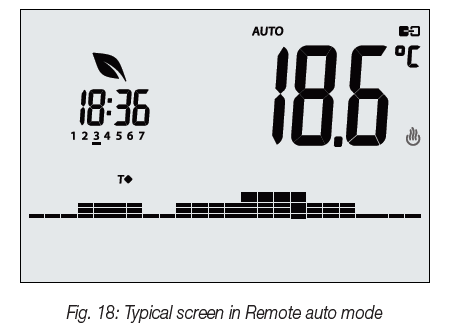
Settings menu
From the settings menu, you can configure all the features of the timer-thermostat.
On the main screen tap the icon![]() .
.
From the main menu, use ![]() and
and ![]() will display the following (flashing) symbols in succession, which provide access to the corresponding submenus:
will display the following (flashing) symbols in succession, which provide access to the corresponding submenus:
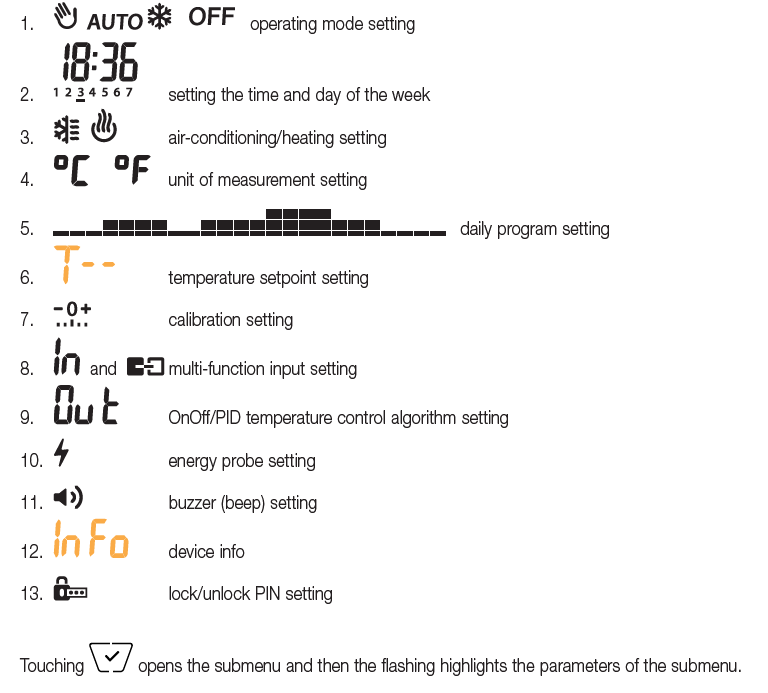
Operating mode setting
This menu is used to select the operating mode of the device:

Setting the time and day of the week
This menu lets you set the time and day of the week. Using![]() ,
,![]() ,
, ![]() and
and ![]() set the hour, confirm with
set the hour, confirm with ![]() and similarly set the minutes and then the day of the week. The days of the week are represented by numbers from 1 to 7 and indicate the days from Monday to Sunday.
and similarly set the minutes and then the day of the week. The days of the week are represented by numbers from 1 to 7 and indicate the days from Monday to Sunday.
Heating/air-conditioning setting
This menu lets you set the operation of the device depending on the season (winter/summer):
 heating
heating air-conditioning
air-conditioning
Using and
and  select the desired operation and confirm with
select the desired operation and confirm with .
.
Unit of measurement setting
This menu lets you set the unit of measurement used for the temperature (°C or °F) Using  and
and  select the desired unit of measurement and confirm with
select the desired unit of measurement and confirm with
Daily program setting
This menu lets you set or modify the time and daily program for the ambient temperature. The program lets you associate each quarter hour of the day (and in a different way, for each of the 7 days) with one of the 3 temperatures “T comfort”, “T away” and “T economy” set previously by the installer. For example: During the night, set “T economy”, for the morning and evening set “T comfort” and in the middle of the day set “T away” (when no one is in the environment and to obtain savings due to a lower consumption).
Selecting the day of the week
As soon as you enter the menu, the display shows a flashing dash for the day to which the current programming refers (for example: 1234567 = Tuesday). Using and
and select the day of the week to program and confirm with
select the day of the week to program and confirm with .
.
Temperature selection
After confirming the day to program, the display shows the screen for setting the temperatures associated with the different times of the day.
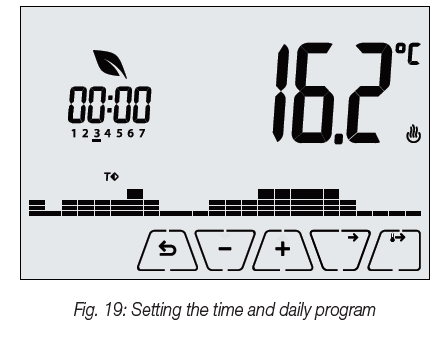
Using and select the temperature to be associated with the current time (which is shown on the clock on the left). This temperature, highlighted by the blinking, can be selected from:
 The “dashes” blinking indicate the time slot that you are setting (there are 24 groups of 3 dashes and each group corresponds to one hour of the 24 in the day). The selected temperature will be applied beginning at the time indicated on the left for all of the next quarter of an hour.
The “dashes” blinking indicate the time slot that you are setting (there are 24 groups of 3 dashes and each group corresponds to one hour of the 24 in the day). The selected temperature will be applied beginning at the time indicated on the left for all of the next quarter of an hour.
- On touching
 , the temperature selected for the current time is assigned to the next quarter of an hour too; in this case the temperature symbol is the same but the current time, shown by the clock, is moved forward by 15 minutes.
, the temperature selected for the current time is assigned to the next quarter of an hour too; in this case the temperature symbol is the same but the current time, shown by the clock, is moved forward by 15 minutes. - Using
 and
and  you can move respectively between the hours of the day and move forwards or backwards 15 minutes at a time.
you can move respectively between the hours of the day and move forwards or backwards 15 minutes at a time. - During the movement, as well as the clock, also the “dashes” indicate the time of day in which you are working. In addition, below the numbers associated with the days of the week, you will see an icon that identifies the temperature set for that specific time.
- The
 and
and buttons permit changing the set temperature. Programming ends when the temperatures have been set for all the hours of the day and the clock displays the time 23:45;
buttons permit changing the set temperature. Programming ends when the temperatures have been set for all the hours of the day and the clock displays the time 23:45;  then tap to confirm.
then tap to confirm. - Finally,
 using
using  and , select one of the following options shown in the numeric field of the display:
and , select one of the following options shown in the numeric field of the display: - to copy the entire time program for the current day to the next day (useful for replicating working days or holidays).
- to move on to program the next day without making a copy of the day you have just set (useful when switching between programming working days and holidays).
- to finish programming. Touch to confirm the selected option.

Temperature setting
This menu is for the sole use of the installer.
Calibration setting
This menu is for the sole use of the installer.
Multi-function input setting
This menu is for the sole use of the installer.
OnOff/PID temperature control algorithm setting
This menu is for the sole use of the installer.
Energy probe setting
This menu is for the sole use of the installer
Buzzer (beep) setting
This menu is available only if the timer-thermostat is connected to the energy probe 02960. This menu lets you enable/disable the device’s buzzer; if it is disabled there will no longer be any sound when you touch the buttons or in cases of confirmation/error. Whereas, in the event of an alarm, the sound signal will always be guaranteed. Using  and
and select “ON” or “OFF” and confirm with
select “ON” or “OFF” and confirm with .
.
Info about the device
This menu is for the sole use of the installer.
Lock/unlock PIN setting
This menu lets you add/change the password to inhibit use of the timer-thermostat. Using![]() and
and ![]() set the three digits of the PIN one at a time and then confirm each set digit with . If you wish to have free access to the thermostat (so without it prompting you for a password) it is sufficient to set the PIN to “000”.
set the three digits of the PIN one at a time and then confirm each set digit with . If you wish to have free access to the thermostat (so without it prompting you for a password) it is sufficient to set the PIN to “000”.
IMPORTANT: Take care to note down the password so that you can use it again for the device when needed.
Alarms
The system is able to generate and report alarm conditions related to monitoring the consumption of electricity. This feature is useful to warn the user of exceeding a defined consumption threshold and give her the chance to intervene by turning off the source of excessive consumption. This will help to avoid potential disconnection of the residual current device or to optimize power consumption according to need.\ The alarm lasts as long as the measured power remains above the alarm level and stops when it falls back below that level.
Cleaning the device
The device, featuring a display with capacitive buttons, requires you to be gentle during the cleaning phase. Avoid using aggressive products. Clean the display with a special cloth for cleaning lenses.
Regulatory compliance
LV directive.
EMC directive.
Standards EN 60730-2-7, EN 60730-2-9. Viale Vicenza, 14 – 36063 Marostica VI – Italy
Tel. +39 0424 488 600 – Fax (Italy) +39 0424 488 188 Fax (Export) +39 0424 488 709 www.vimar.com
Reference:
Download Manual:
VIMAR 02910 Timer-Thermostat User Manual


Leave a Reply